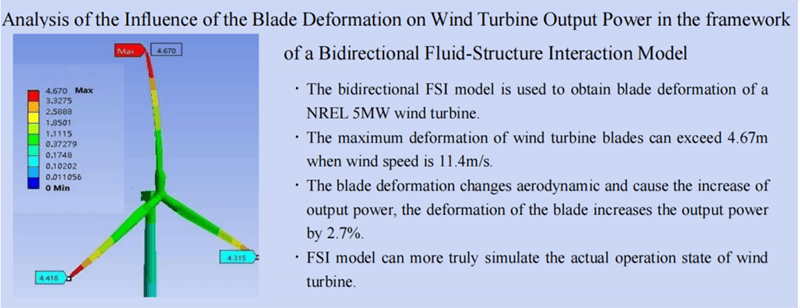 Open Access
Open Access
ARTICLE
Analysis of the Influence of the Blade Deformation on Wind Turbine Output Power in the Framework of a Bidirectional Fluid-Structure Interaction Model
1 CHN Energy United Power Technology Co., Ltd., Beijing, 100036, China
2 School of Energy and Power Engineering, Shandong University, Jinan, 250061, China
3 School of Renewable Energy, North China Electric Power University, Beijing, 102206, China
* Corresponding Author: Zhenggang Liu. Email:
Fluid Dynamics & Materials Processing 2023, 19(5), 1129-1141. https://doi.org/10.32604/fdmp.2023.023538
Received 30 April 2022; Accepted 26 July 2022; Issue published 30 November 2022
Abstract
The blades of large-scale wind turbines can obviously deform during operation, and such a deformation can affect the wind turbine’s output power to a certain extent. In order to shed some light on this phenomenon, for which limited information is available in the literature, a bidirectional fluid-structure interaction (FSI) numerical model is employed in this work. In particular, a 5 MW large-scale wind turbine designed by the National Renewable Energy Laboratory (NREL) of the United States is considered as a testbed. The research results show that blades’ deformation can increase the wind turbine’s output power by 135 kW at rated working conditions. Compared with the outcomes of the simulations conducted using the model with no blade deformation, the results obtained with the FSI model are closer to the experimental data. It is concluded that the bidirectional FSI model can replicate the working conditions of wind turbines with great fidelity, thereby providing an effective method for wind turbine design and optimization.Graphic Abstract

Keywords
Cite This Article
 Copyright © 2023 The Author(s). Published by Tech Science Press.
Copyright © 2023 The Author(s). Published by Tech Science Press.This work is licensed under a Creative Commons Attribution 4.0 International License , which permits unrestricted use, distribution, and reproduction in any medium, provided the original work is properly cited.


 Submit a Paper
Submit a Paper Propose a Special lssue
Propose a Special lssue View Full Text
View Full Text Download PDF
Download PDF Downloads
Downloads
 Citation Tools
Citation Tools